Early Ducommun Yard
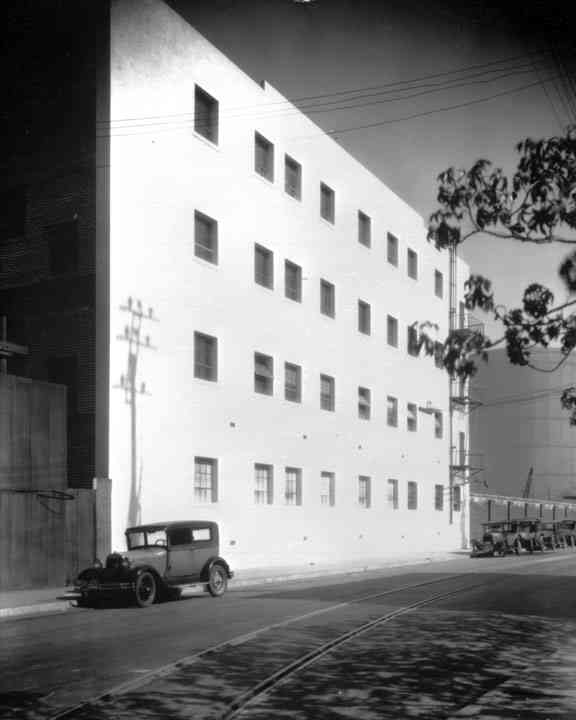 |
|
| (1926)* - Ducommun Street warehouse. In the distance is a large large gas tank owned by the LA Gas and Electric Corporation (aka Gasometer) |
From the LADWP Historic Archive
October 1926 -
The buildings and yard occupy a five-acre piece of land, bounded by Alameda, Ducommun and Hewitt Streets, or another description would be, just across Alameda Street from where, about fifty-five years ago, the first passenger depot and locomotive roundhouse in Los Angeles were located. The name “Ducommun” Mr. Chas. Ducommun, for whom this street was named, was one of the original stockholders and a director of the Los Angeles City Water Works, the parent of the present Los Angeles City Water Department. Mr. Ducommun at that time was one of our leading citizens and hardware merchants.
The Warehouse, with a floor space of one hundred by two hundred and twenty feet, which is separated from the machine shop by a brick partition, is under the supervision of L. R. Anderson. It is a light, cool, conveniently arranged room, modern in every respect, and it is a valuable asset to the Water Department and should be seen to be appreciated. Anderson, with a crew of thirty-four men, receives warehouse goods and material of an almost unlimited variety for distribution to all parts of the Water Works. The money value of material and supplies issued by the warehouse amounted to about two million, eight hundred and seventy-four thousand, six hundred and thirty-seven dollars for the year just closed (1925).^
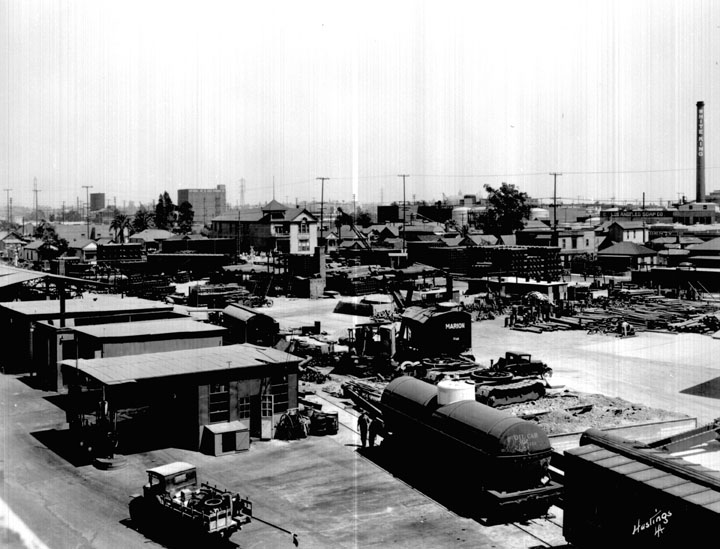 |
|
| (1930)* - Ducommun Street yard. Seen above is one corner of the large pipe storage area. |
From the LADWP Historic Archive
October, 1930 - Concentrated at Ducommun Yards are an innumerable quantity of Water Bureau activities necessary to the efficient operation of the vast water system of Los Angeles. After considerable moving around and adjustments of materials and buildings, Ducommun now is occupying its big new yards.
More than three years ago street main activities were moved to Ducommun. This included the machine shops, water transportation, and meter service shops, pipe and salvage yards, etc. Requirements quickly grew quite beyond the space available. The Department negotiated for purchase of properties occupied by the Pioneer Truck Company.
Originally Ducommun consisted of 5.13 acres. The acquirement of the new portion brought the total acreage to 7.88. This gives 400 feet frontage on Alameda, Jackson and varies on the other streets from 369.47 feet to 189 feet.
Nearly one thousand men work in and out of Ducommun. There are 294 in the Street Mains section, 36 in the water warehouse, 53 in Yard and Salvage, 320 in Meter and Service, 115 in the shops and 43 in transportation.
Ducommun is a busy place. Locomotives shunt cars into the yards for delivery of pipe. Large cranes move about with their cargo of pipe to be stacked in neat tiers in the pipe yard or carried from the stacks to waiting trucks.
Trucks back up to the loading platforms to receive the materials needed for the day’s work in the field. From 7 to 7:30 in the morning scores of trucks line up for orders and move out quickly to carry Water Service throughout the City of Los Angeles.
The whirr of machinery is heard in the machine shop where expert mechanics work in metal fashioning materials for use by the Department, or repairing parts worn or broken is use.
In the meter shop schooled testers are busy examining water meters that will gauge the amount of water used by the consumers.
The buzz of the saw and the snap of the hammer may be heard in the carpenter shop which occupies one floor of the new building at the extreme side of the new portion of the yard. In this new structure also may be found the storeroom, various offices for personnel of sundry sections.
Draftsmen, clerical forces and others who contribute their time and efforts to the carrying forward of Water Service, occupy other buildings in the Ducommun Yards.^
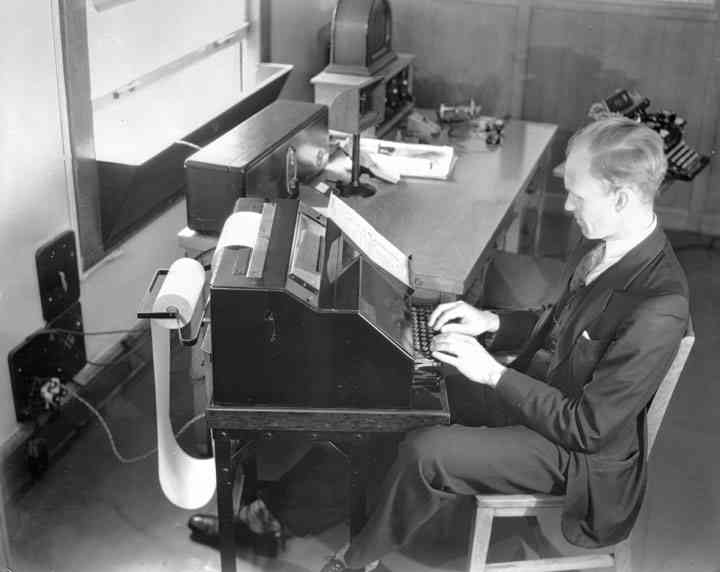 |
|
| (1930)* - Teletype machine and operator - G. C. Farmer operating New Page Teletype acquired by the Department for use between Los Angeles and Owens Valley. |
From the LADWP Historic Archive
August, 1930 – Marked increase in the telegraphic facilities between Los Angeles and Owens Valley has resulted from the installation of page teletype machines in the Los Angeles office and in Independence. This equipment in the radio-telegraph office renders more efficient and speedy the service from here to the valley and back.
The teletype machines which are sometimes called printing telegraph machines operate like an ordinary typewriter. The messages are typewritten on the sending machine and at the same time transmitted over one of the Owens Valley telephone lines to the receiving machine which reproduces the message on a page automatically, instantly, and accurately in typewritten form.
The teletype machine consists of a basket carrying a set of type bars similar to that of a typewriter, these type bars being mechanically thrown against a platen or roller, thus causing letters to be printed. The type bar to be selected when the teletype is receiving the message is determined by the setting of five code bars which are actuated by five selector magnets controlled by the line signals. The code bars are so arranged that notches on their under sides will be lined up permitting a certain push bar which is linked to the type bar to move upward into the path of the striker bail. This bail moves the push bar which causes the type bar to move against the platen or roller holding the paper.
MECHANICAL FEATURES – the various functions, line feed, space, carriage return, figures, letters, and signal bell are also accomplished mechanically.
The only electrical equipment in the printer is five small selector magnets for operating the code bars, a sixth pulse magnet which starts the operation of the printer, two small motors which drive the mechanism, and a line relay. The various operations of the teletype are accomplished by a series of cams arranged on a shaft so that the operation of the various levers will be in a certain sequence.
Messages are transmitted by teletype machines over the Owens Valley telephone line at a speed of sixty words per minute without interfering in any way with the telephone conversation over the same line.
TWO CIRCUITS – The Department has two metallic circuits which extend from Los Angeles into Owens Valley over which two telephone conversations may be carried on and two telegraphic messages may be transmitted at the same time.
The demand for telephone service over the Owens Valley lines has increased until it has become necessary to ask people to wait their turn for connections. Messages and reports of all kind, regardless of their length, are being sent by teletype with promptness, accuracy, and absolute privacy which surpasses that of the telephone service. It is impossible for anyone, either by tapping or coupling with the telephone line, to read or interrupt the pulses or signals sent over the line by the teletype machines.
Many sections of the Department have taken full advantage of the teletype service while other sections are relying entirely upon telephone and mail services. Telegrams to Owens Valley from 410 Ducommun Street and 1630 North Main Street may be dictated over the telephone (Station 728) to the operator in room 575, Arcade. Messages of any length pertaining to departmental business will be called for, transmitted, and delivered promptly, by calling the telegraph office.^
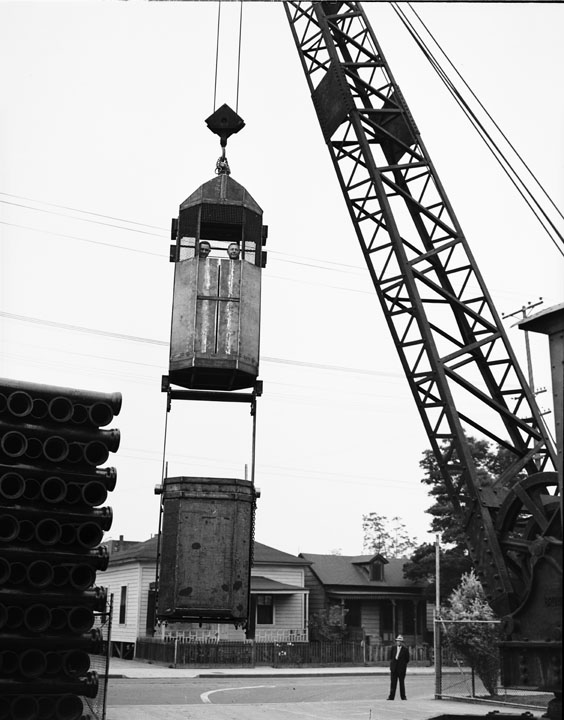 |
|
| (1935)* - First ride in the cage that will carry miners up and down Shaft No. 1 of Mono Craters Tunnel was had by Robert Hoefer and Robert Jessen of Ducommun Shops, where unit was fabricated. |
Historical Notes
November 1935 – Work on the Mono Craters Tunnel Project entered a new phase last month with start of excavation at two additional locations; it was announced by H. A. Van Norman, Chief Engineer and General Manager of the Water Bureau.
Designated as Headings No. 4 and 5, the two new excavation points are located 299 feet below the ground surface a t Shaft No. 2. Heretofore the 11 mile tunnel was being bored from only the East and West Portals and it is expected now that the rate of progress will be practically doubled.
The first shovelful of earth on the Shaft No. 2 project was turned February 9, 1935 last. Since that time the shaft has gone slowly but steadily downward at an average rate of 2.75 feet per day for three shifts. Although the tunnel level is 299 feet below surface, the shaft actually extends to a total depth of 362.5 feet to the bottom of a 63.5 feet muck pocket.
Working under the supervision of Ed Cahill, the shaft was sunk in 132 working days of 290 shifts. Best 24-hour record was 10.5 feet, the formation encountered on that record day being sedimentary sand and clay. The entire tunnel project is under the direction of Hugh Mulholland.^
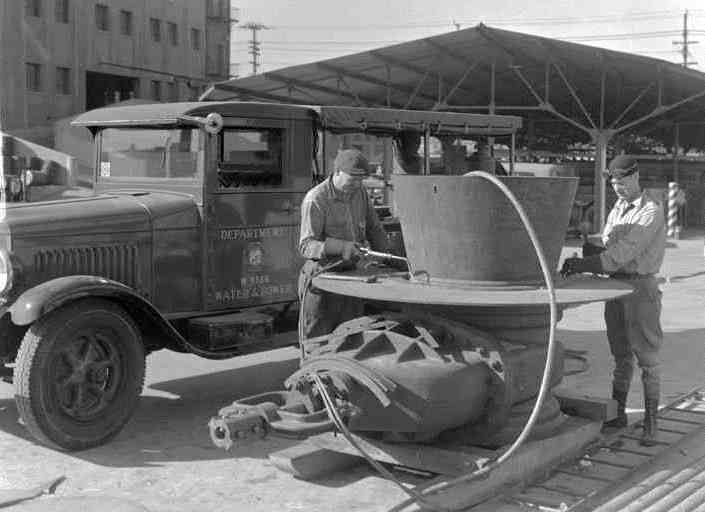 |
|
| (1937)* - Welders working on 30" gate for Crystal Springs siphon at the Ducommun Yard Shops. |
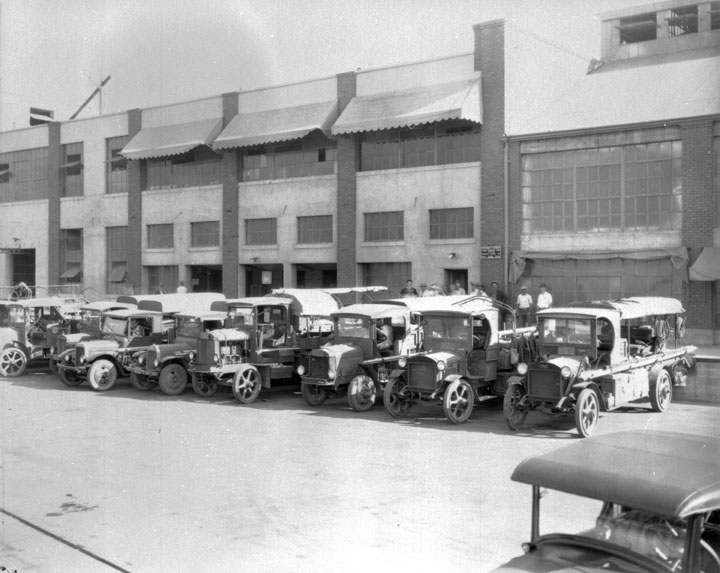 |
|
| (1930)* - Power trucks at the Ducommun Street yard. |
From the LADWP Historic Archive
October 1930, Concentrated at Ducommun Yards are an innumerable quantity of Water Bureau activities necessary to the efficient operation of the vast water system of Los Angeles. After considerable moving around and adjustments of materials and buildings, Ducommun now is occupying its big new yards
More than three years ago street main activities were moved to Ducommun. This included the machine shops, water transportation, and meter service shops, pipe and salvage yards, etc. Requirements quickly grew quite beyond the space available. The Department negotiated for purchase of properties occupied by the Pioneer Truck Company.
Originally Ducommun consisted of 5.13 acres. The acquirement of the new portion brought the total acreage to 7.88. This gives 400 feet frontage on Alameda, Jackson and varies on the other streets from 369.47 feet to 189 feet.
Nearly one thousand men work in and out of Ducommun. There are 294 in the Street Mains section, 36 in the water warehouse, 53 in Yard and Salvage, 320 in Meter and Service, 115 in the shops and 43 in transportation.
Ducommun is a busy place. Locomotives shunt cars into the yards for delivery of pipe. Large cranes move about with their cargo of pipe to be stacked in neat tiers in the pipe yard or carried from the stacks to waiting trucks.
Trucks back up to the loading platforms to receive the materials needed for the day’s work in the field. From 7 to 7:30 in the morning scores of trucks line up for orders and move out quickly to carry Water Service throughout the City of Los Angeles.
The whirr of machinery is heard in the machine shop where expert mechanics work in metal fashioning materials for use by the Department, or repairing parts worn or broken is use.
In the meter shop schooled testers are busy examining water meters that will gauge the amount of water used by the consumers.
The buzz of the saw and the snap of the hammer may be heard in the carpenter shop which occupies one floor of the new building at the extreme side of the new portion of the yard. In this new structure also may be found the storeroom, various offices for personnel of sundry sections.
Draftsmen, clerical forces and others who contribute their time and efforts to the carrying forward of Water Service, occupy other buildings in the Ducommun Yards.^
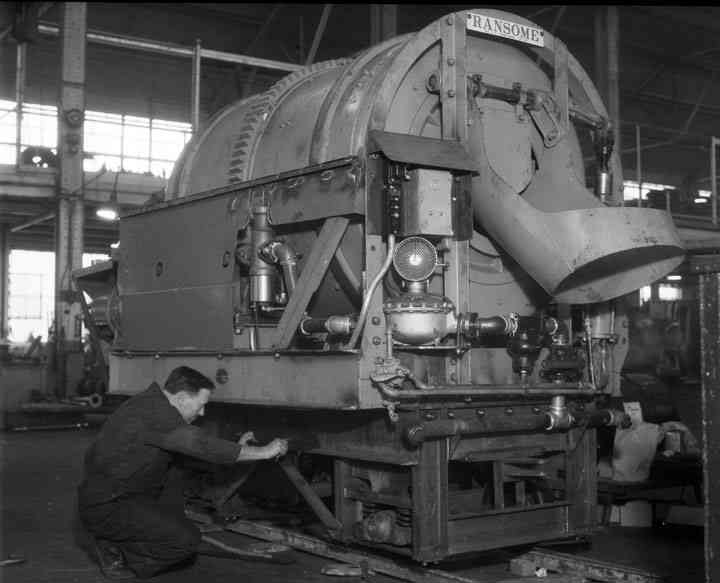 |
|
| (1937)* - Concrete mixer for Meno Craters tunnel work, under construction at Ducommun shops. |
Ducommun Yard Group Photos
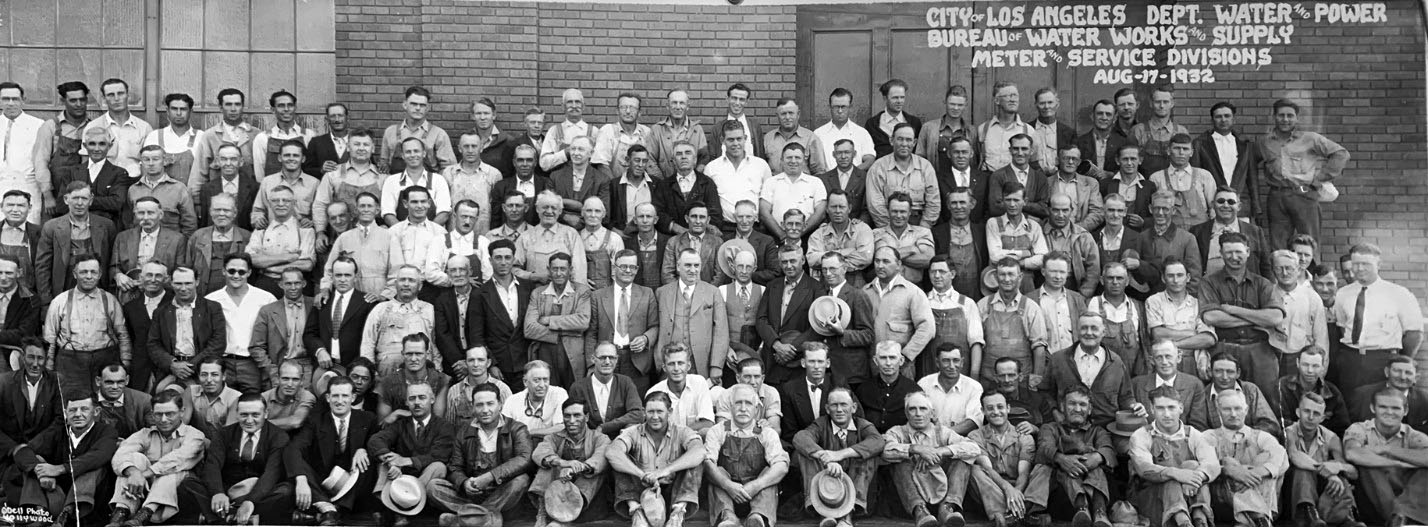 |
|
| (1932)** - Meter & Service Division – Bureau of Water Works and Supply. Photo courtesy of Tim Hayes in honor of his Grandfather and Great Grandfather (John Caput Jr. and John Caput Sr.) who both worked at DWP. |
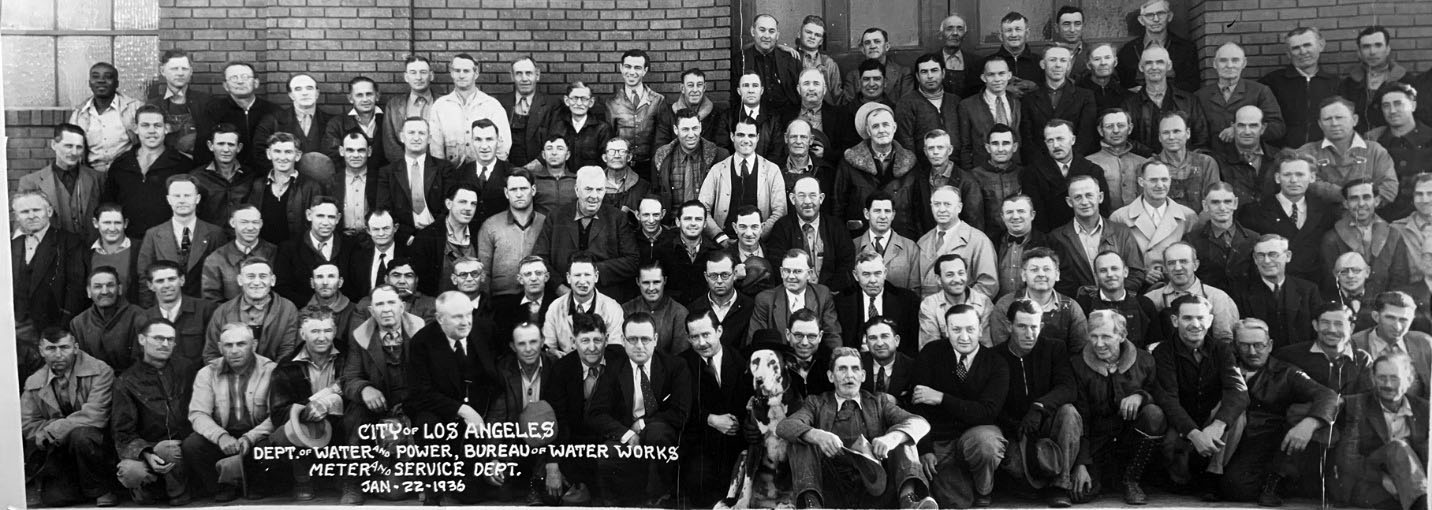 |
|
| (1936)** - Meter & Service Division – Bureau of Water Works and Supply. Photo courtesy of Tim Hayes in honor of his Grandfather and Great Grandfather (John Caput Jr. and John Caput Sr.) who both worked at DWP. |
Meter Shop
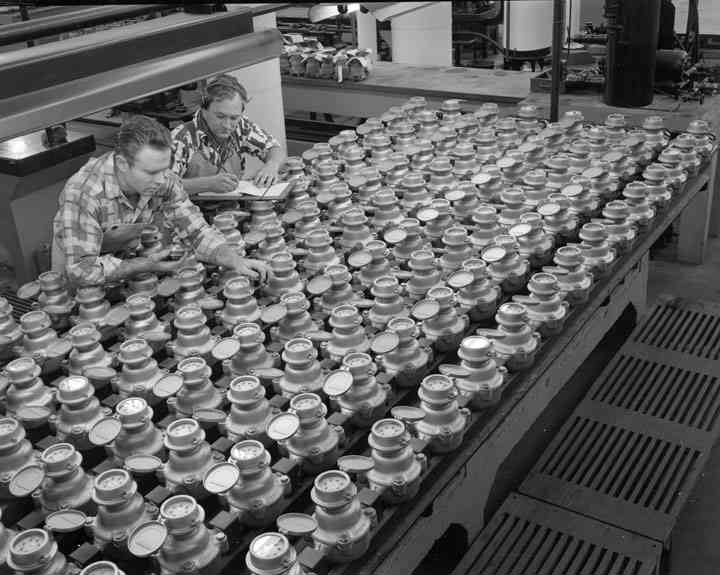 |
|
| (1942)* - Harold Breedlove and Thomas Dietrich checking water meters at Ducommun. |
From the LADWP Historic Archive
May 1942 -
Mass production methods in testing water meters have been developed and put into operation at the Ducommun shops of the Meter and Service section, resulting in increased efficiency and accuracy.
Through perfection of a new setup, a bank of 160 water meters, in either the 5/8 x ¾ x 1-inch sizes may be tested at one time, where formerly a total of only 10 could be tested simultaneously. These two sizes represent approximately 75 percent of the 311,095 meters in service (February 28, 1942).
In making a test, the test tank is filled with exactly 10 cubic feet of water, a valve is turned and the water permitted to flow through the 160 meters which are connected in series.
When the tank has been emptied, and if the meters are 100 percent accurate, each will show on its dial a reading of 10 cubic feet. Any variation over or under that quantity represents the percentage of error. Tests made to date disclose an average accuracy of 98.38 percent.
Since monthly water bills are computed from the consumption registered by the water meter, it is highly important that the meters be maintained at as high a percentage of accuracy as is humanly possible so that the customer pays only for the water actually consumed and the Department is paid for all the water it supplies.
In addition to meter tests before installation, periodic tests of meters in service are made. At regular intervals several meters from different sections of the municipal water system are brought into the shops for test and inspection, it was stated by George C. Sopp, superintendent of meters and services. Average number of meters tested monthly is 1,600, about equally divided between new and old meters.
Records show that meters which have been in service as long as 20 years still give satisfactory performance. Such excellent service is due in great part to rigid purchase specifications.
Whenever a new shipment is received from any of the several manufacturers, several meters are selected at random and subjected to exhaustive tests which include registration, ability to withstand hydrostatic pressures up to 350 pounds per square inch and chemical analyses of the main casing, register gearing, train gears and measuring chamber.
Today the water distribution system’s more than 300,000 meters record the monthly consumption of some 1,500,000 city inhabitants. In the last fiscal year, the system distributed an average of 219,000,000 gallons daily, of which 175,000,000 gallons were from domestic consumption at the low municipal rate of 14.8 cents for 100 cubic feet. Daily consumption per capita was 119 gallons, which would cost a fraction over two cents.
Contrast this sum with the price paid for water in the early days of the City’s history. When Los Angeles still was a sleepy pueblo of only a few hundred souls, a local character named Bill the Waterman supplied residents with water from the Los Angeles River for a price of 50 cents per bucket.
Another interesting contract to this simple cash transaction of “four bits” a bucket is the complicated water rate structure of 1907 which required the combined abilities of architect, contractor, surveyor, census taker and statistician.
First consideration in determining the base water rate then was the number of rooms in a house, a different rate applying for each size home from three to 10 rooms. For each room over 10, five cents extra was charged.^
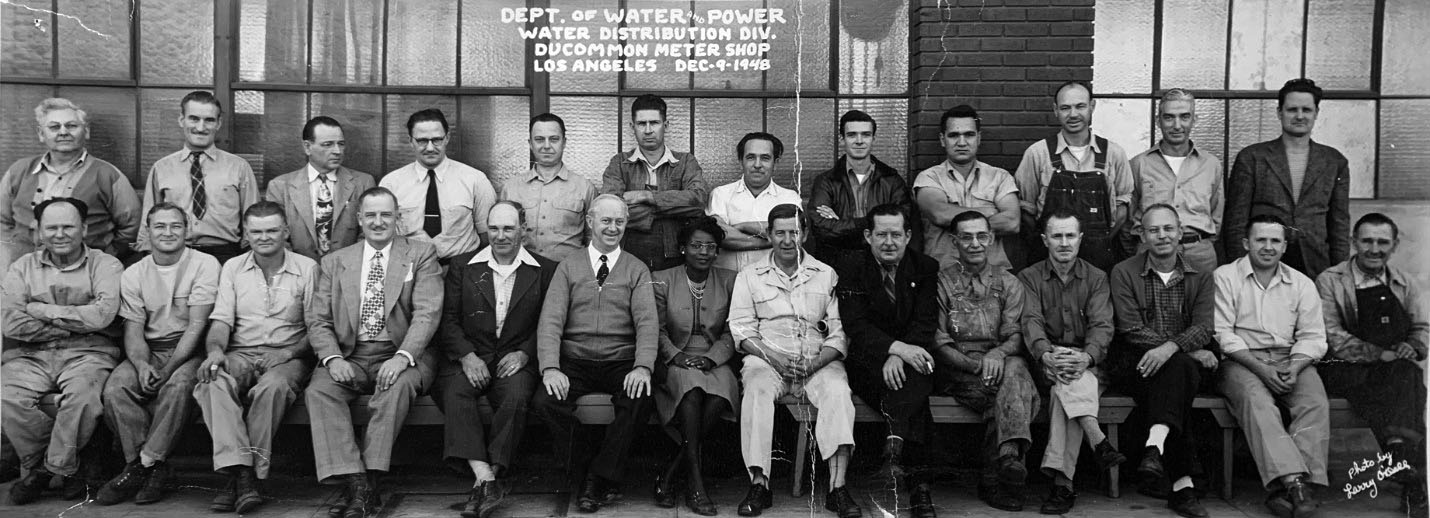 |
|
| (1948)** – Ducommun Meter Shop – Water Distribution Division. Photo courtesy of Tim Hayes in honor of his Grandfather and Great Grandfather (John Caput Jr. and John Caput Sr.) who both worked at DWP. |
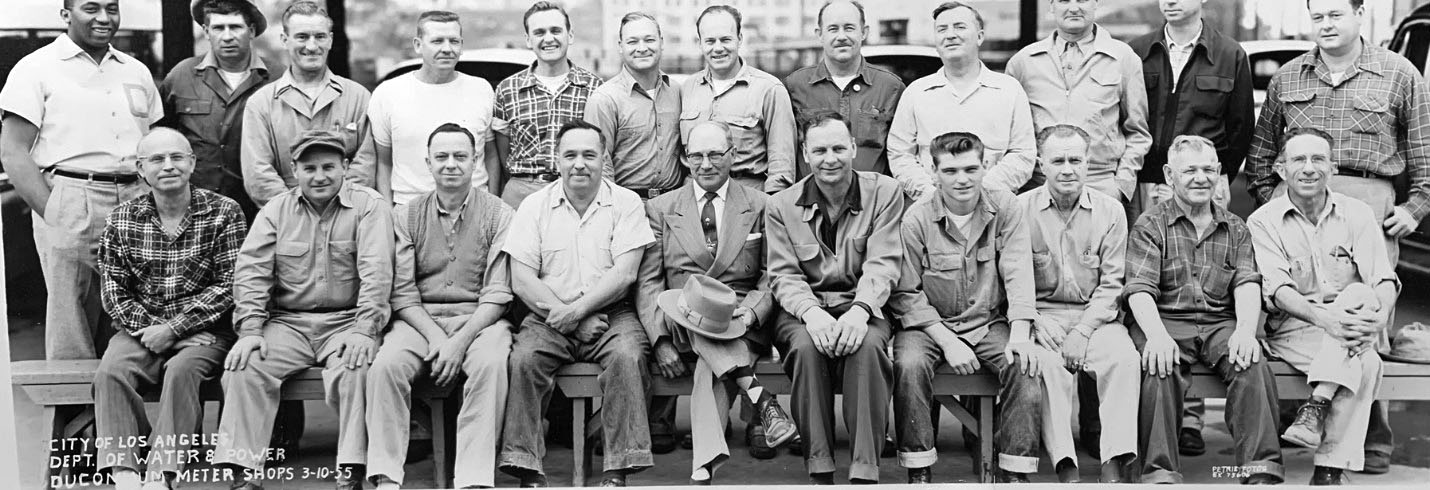 |
|
| (1955)** - Ducommun Meter Shops. Photo courtesy of Tim Hayes in honor of his Grandfather and Great Grandfather (John Caput Jr. and John Caput Sr.) who both worked at DWP. |
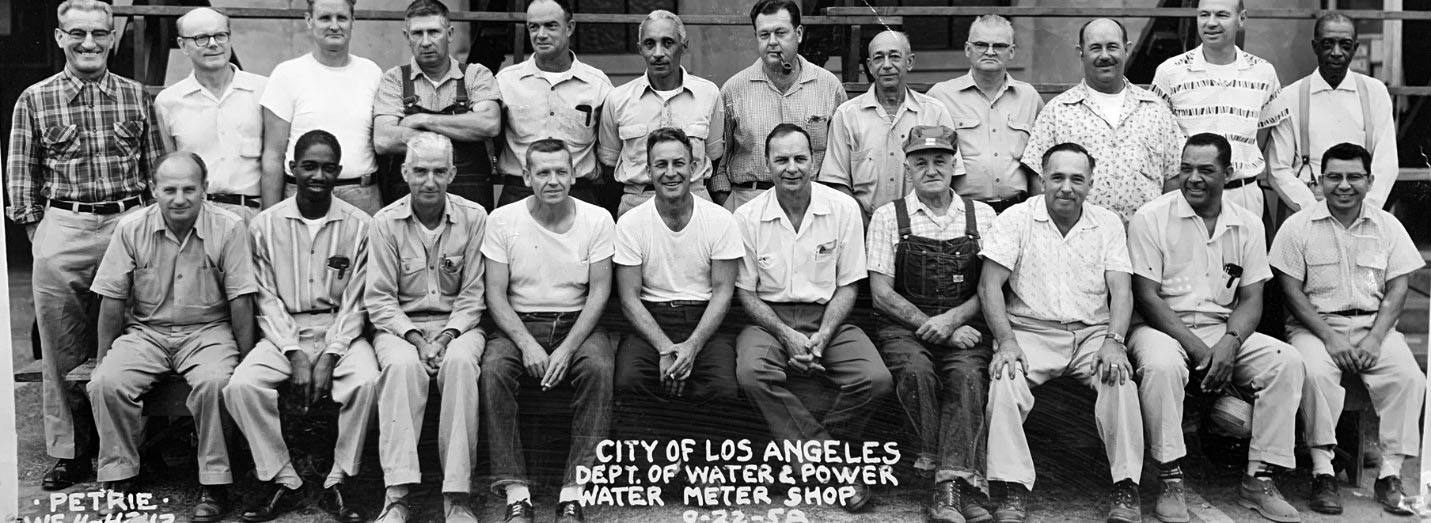 |
|
| (1958)** – Ducommun Meter Shop – Water Distribution Division. Photo courtesy of Tim Hayes in honor of his Grandfather and Great Grandfather (John Caput Jr. and John Caput Sr.) who both worked at DWP. |
Ducommun Water Yard
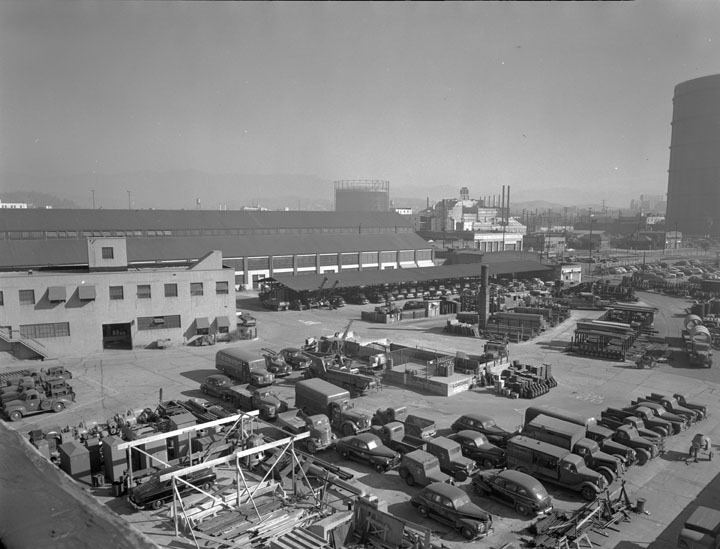 |
|
| (1953)* - Overall view of Water Yard at Ducommon Street. |
Water Petty Trouble Board
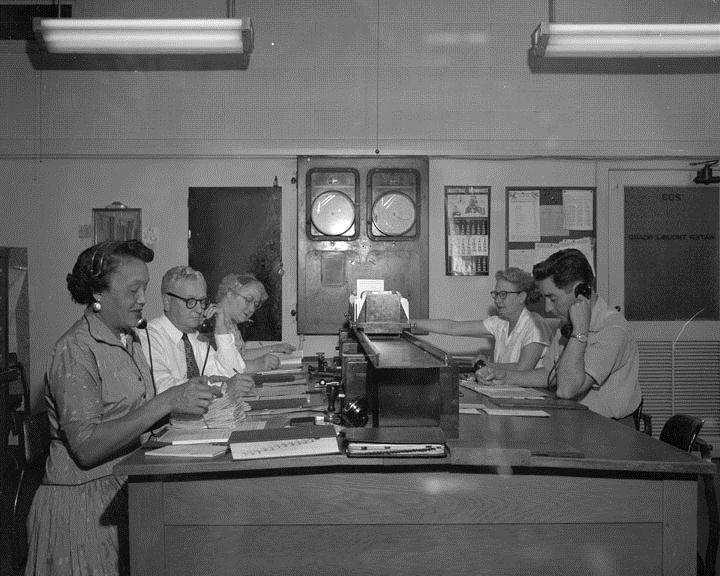 |
|
| (1954)* - Water petty trouble board at 410 Ducommun Street. |
1970s Ducommun Yard
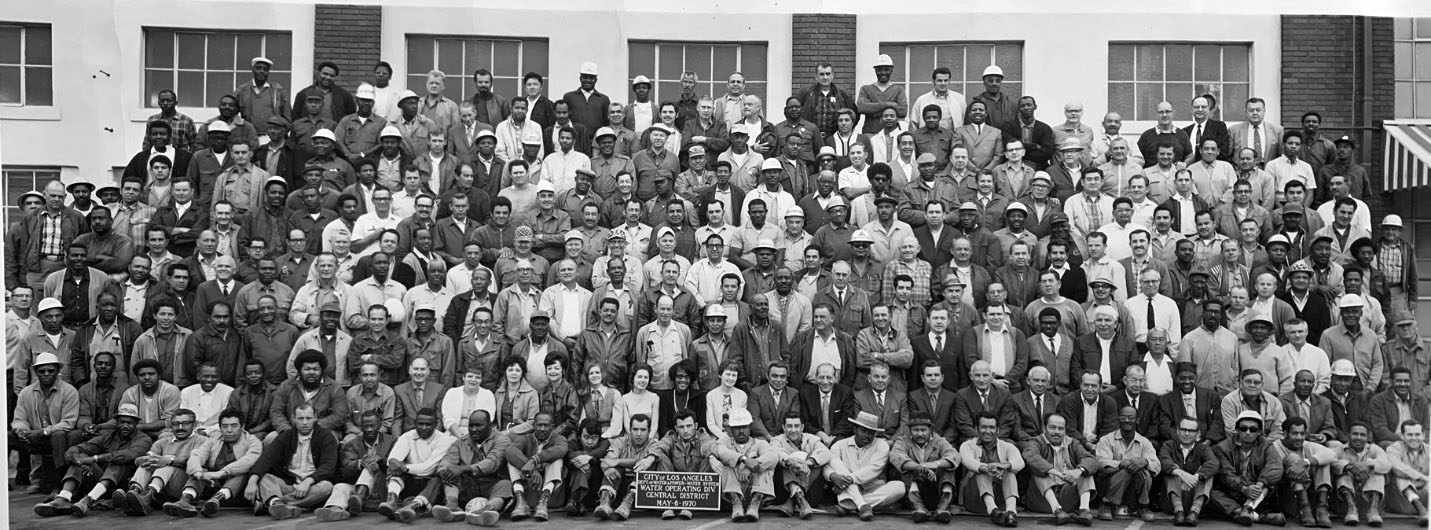 |
|
| (1970)** – Ducommun Meter Shops – Water Distribution Division. Photo courtesy of Tim Hayes in honor of his Grandfather and Great Grandfather (John Caput Jr. and John Caput Sr.) who both worked at DWP. |
Meter Shop
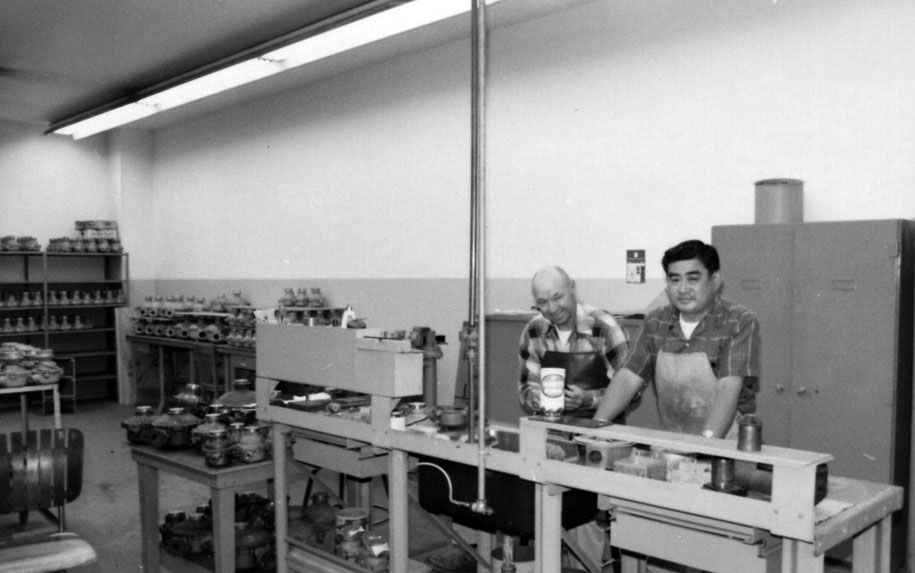 |
|
| (1971)** - John Caput Jr. (left) and unidentified man (right) stand behind the work bench at the Meter Shop in Ducommun. Photo courtesy of Tim Hayes in honor of his Grandfather and Great Grandfather (John Caput Jr. and John Caput Sr.) |
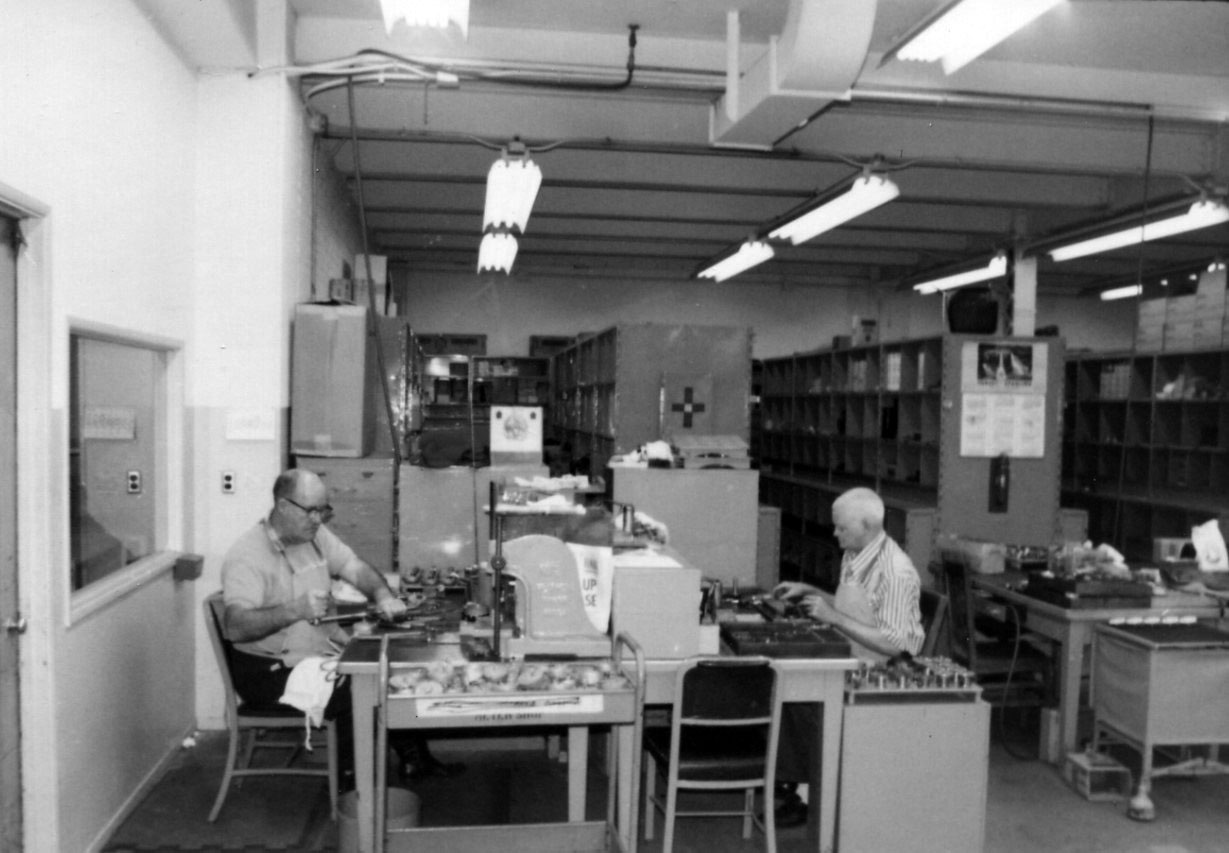 |
|
| (1971)** – Meter Shop |
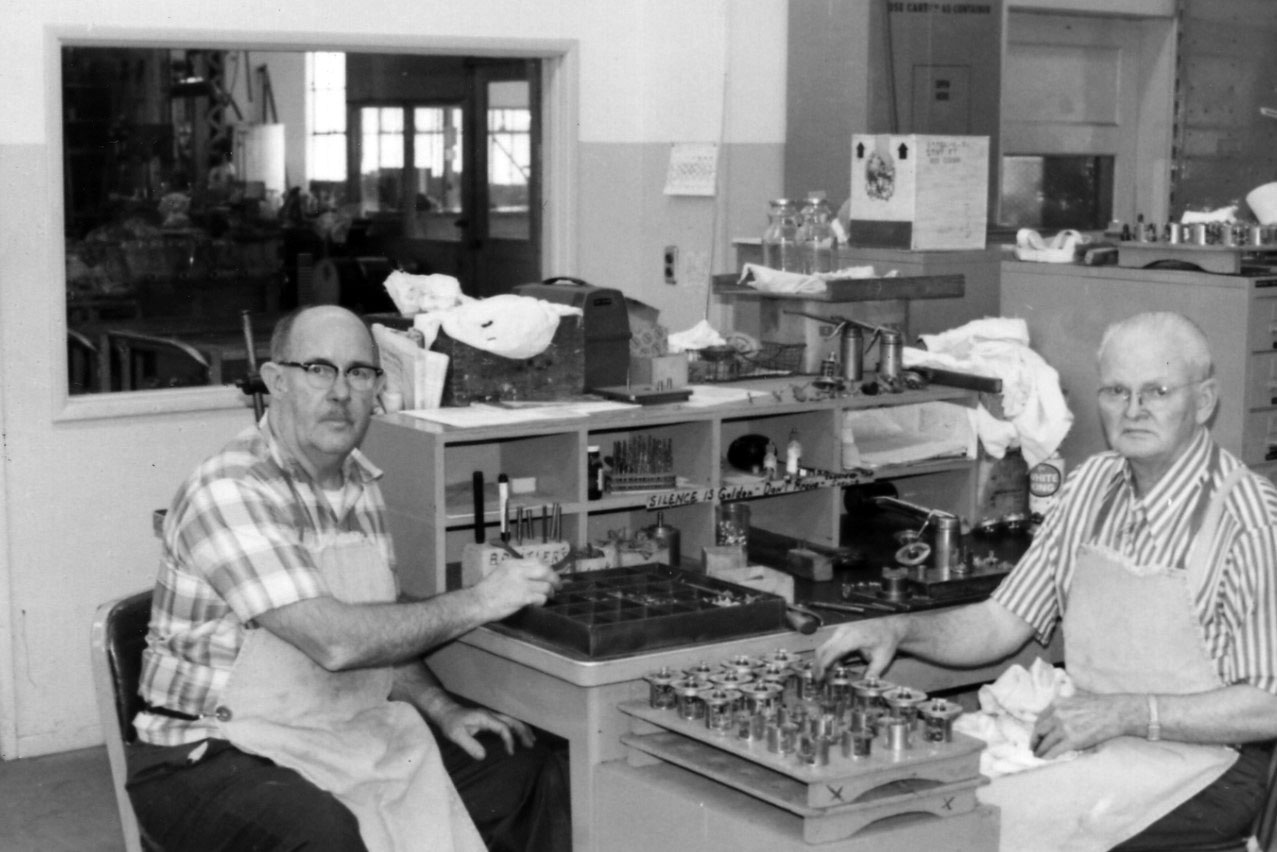 |
|
| (1971)** – Sorting out meter components. |
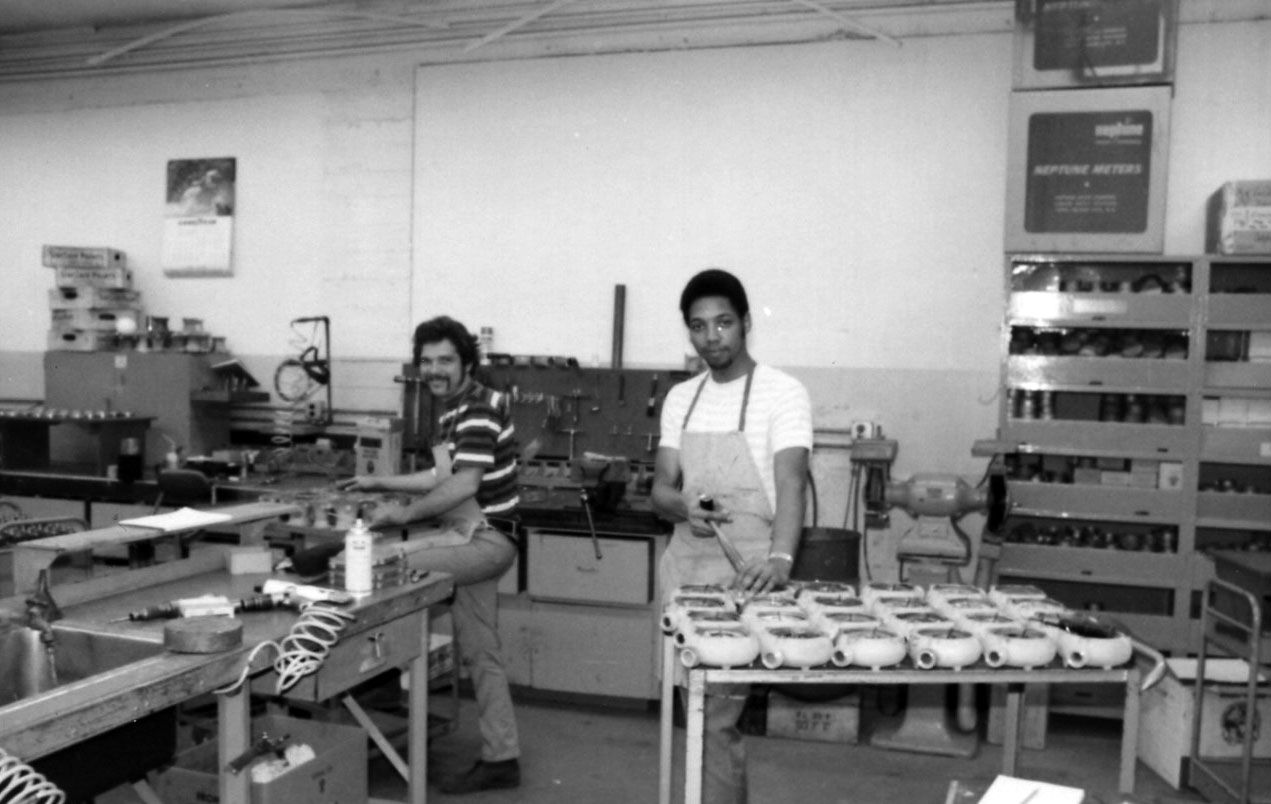 |
|
| (1971)** – Meter Shop |
1980s - Ducommun Yard
.jpg) |
|
| (1980s)* - Ducommun Yard - Photo Courtesy of Lou Ciminieri |
.jpg) |
|
| (1980s)*- Ducommun Yard - Photo Courtesy of Lou Ciminieri |
.jpg) |
|
| (1980s)* - Ducommun Yard - Photo Courtesy of Lou Ciminieri |
.jpg) |
|
| (1980s)* - Ducommun Yard - Photo Courtesy of Lou Ciminieri |
Ducommun Yard (Contemporary View)
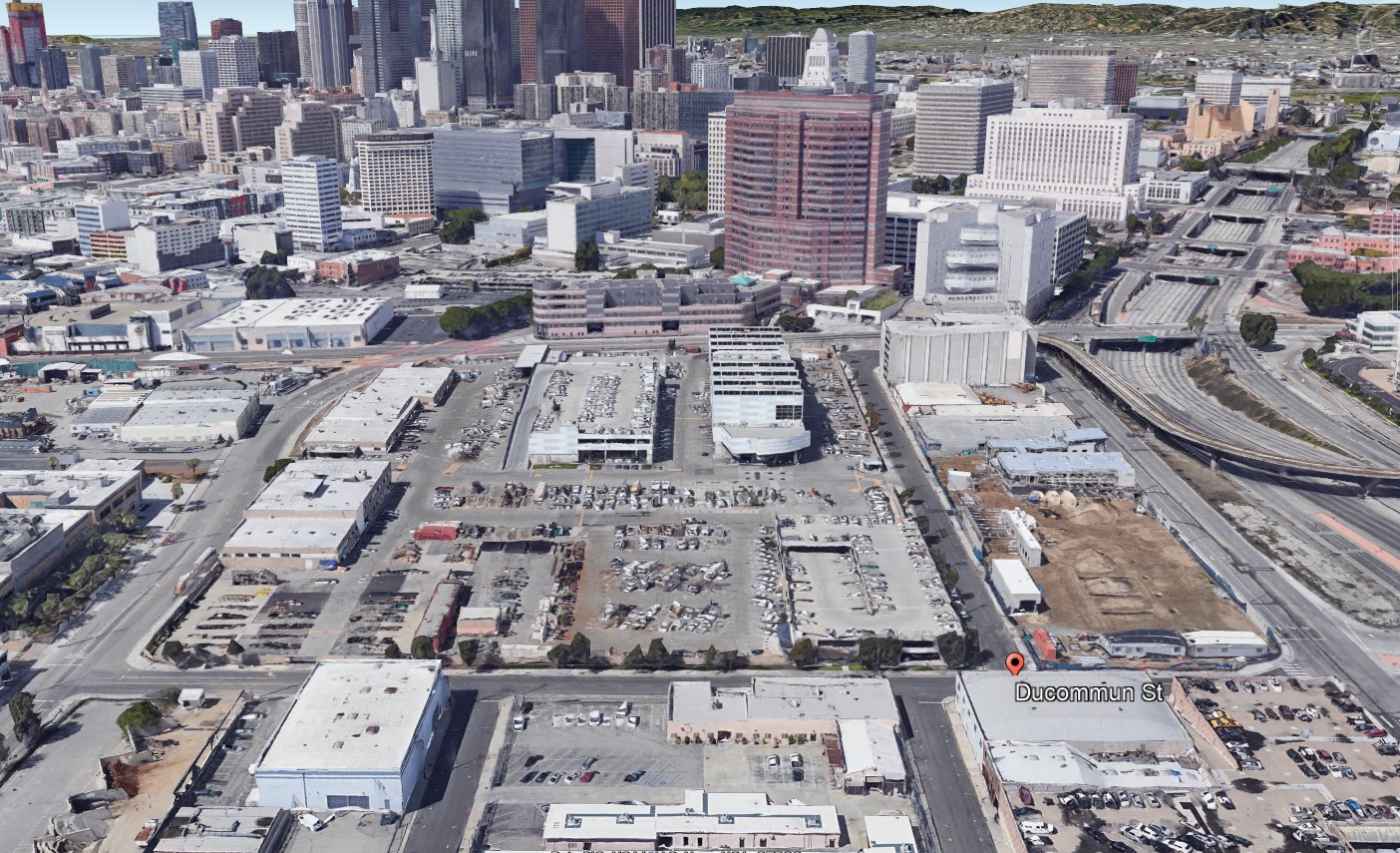 |
|
| (2019) – Google Earth View looking SW showing the Ducommun Water Yard and Fleet Services at center of photo with the Hollywood Freeway seen on the right. |
Reference
* DWP - LA Public Library Image Archive
^LADWP Historic Archive
**Photo courtesy of Tim Hayes in honor of his Grandfather and Great Grandfather (John Caput Sr. and John Caput Jr.) who both worked at DWP.
< Back
Menu
- Home
- Mission
- Museum
- Mulholland Service Award
- Major Efforts
- Board Officers and Directors
- Positions on Owens Valley and the City of Los Angeles Issues
- Legislative Positions on
Water Issues
- Legislative Positions on
Energy Issues
- Recent Newsletters
- Historical Op Ed Pieces
- Membership
- Contact Us
- Search Index